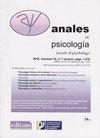青少年的生活质量。COVID-19大流行影响的纵向研究
IF 1.3
4区 心理学
Q3 PSYCHOLOGY
引用次数: 0
摘要
几项研究报告说,在新冠疫情期间,青少年的健康相关生活质量(HRQOL)有所下降。在这项研究中,对疫情结束后13至17岁的年轻人进行了HRQOL分析。为此,我们在时间上遵循了三个不同的点:大流行之前(2019年)、期间(2021年)和大流行限制之后(2022年)。采用了三阶段的时差设计,共有2027名青少年完成了儿童屏幕-10 HRQOL问卷。采用方差分析和Logistic回归模型分析了性别、体育锻炼和心理健康治疗的影响。获得的结果显示,2021年,年轻人在混合学习的基础上重返学校,人权状况恶化。无论性别如何,这种恶化都发生了。2022年,一旦取消所有限制,男孩们将与健康有关的生活质量恢复到大流行前的水平,但女孩却没有这样做。接受心理健康治疗的年轻人也是如此。在所有情况下,运动都被证明是人权高专办的一个保护因素,各种研究报告说,在新冠疫情期间,青少年的健康相关生活质量有所下降。这项工作分析了疫情结束后13至17岁年轻人的心血管疾病。为此,在三个不同的时间进行了监测:大流行前(2019年)、大流行限制期间(2021年)和大流行限制之后(2022年),采用了三阶段的时间延迟设计,共有2027名青少年完成了CVRS的Kidscreen-10问卷。通过方差分析和Logistic回归模型分析了性别、体育锻炼和接受治疗对心理健康的影响。所获得的结果表明,2021年,当年轻人重返半面对面的教育机构时,CVR恶化。这一下降与性别无关。2022年,一旦取消所有限制,男孩的心率恢复到青春期前的水平,但女孩的心率没有恢复到青春期前的水平。接受心理健康治疗的年轻人也是如此。在所有情况下,体育锻炼都被证明是心血管疾病的保护因素。本文章由计算机程序翻译,如有差异,请以英文原文为准。
Quality of life in adolescents. A longitudinal study of the impact of the COVID-19 pandemic
Several studies have reported that health-related quality of life (HRQoL) in adolescents has decreased during the COVID-19 pandemic. In this study, HRQoL was analyzed in young people aged 13 to 17 years after the end of the pandemic. For this purpose, we followed up at three different points in time: before the pandemic (2019), during (2021) and after the pandemic restrictions (2022). A time-lag design in three phases was used, with a total of 2027 adolescents completing the Kidscreen-10 HRQoL questionnaire. ANOVA and logistic regression models were used to analyze the influence of gender, playing sports and mental health treatment. The results obtained showed a worsening of HRQoL in 2021, when young people returned to school on a blended learning basis. This worsening occurred regardless of gender. In 2022, once all restrictions were removed, boys recovered health-related quality of life to pre-pandemic levels, but this did not occur in girls. The same happened with young people in mental health treatment. In all cases, doing sports was shown to be a protective factor for HRQoL
Diversos estudios han informado que la calidad de vida relacionada con la salud (CVRS) en adolescentes ha disminuido durante la pandemia por COVID-19. En este trabajo se analizó la CVRS en jóvenes de 13 a 17 años una vez finalizada la pandemia. Para ello se hizo un seguimiento en tres momentos diferentes: antes de la pandemia (2019), durante las restricciones de la pandemia (2021) y tras las restricciones de la misma (2022).
Se utilizó un diseño de retardo temporal (time-lag design) en tres fases, con un total de 2027 adolescentes que cumplimentaron el cuestionario Kidscreen-10 de CVRS. Mediante modelos ANOVA y de regresión logística se analizó la influencia del género, la práctica deportiva y estar en tratamiento en salud mental. Los resultados obtenidos mostraron un empeoramiento de la CVRS en 2021, cuando los jóvenes volvían a los centros educativos en régimen de semipresencialidad. Este descenso fue independiente del género. En 2022, una vez eliminadas todas las restricciones, la CVRS se recuperó a niveles prepandemia en los chicos, pero no en las chicas. Lo mismo ocurrió con los jóvenes en tratamiento de salud mental. En todos los casos, la práctica deportiva se mostró como un factor protector de la CVRS.
求助全文
通过发布文献求助,成功后即可免费获取论文全文。
去求助
来源期刊

Anales De Psicologia
医学-心理学
CiteScore
3.30
自引率
5.90%
发文量
57
审稿时长
4-8 weeks
期刊介绍:
Anales de Psicologia / Annals of Psychology is a multidisciplinary journal of the various thematic areas of scientific psychology. It publishes original research articles and theoretical review in any of its basic, applied and methodological areas included within psychology.
Publishing, financing, marketing and distribution corresponds Editum: Editions of the University of Murcia (Spain). The organizational guidelines and editorial policies come from the Editorial Team (elected for four years by the Areas and / or Departments of Psychology at the University of Murcia) and the Editorial Board, composed of scholars and experts from different universities and institutions national and international. It is published in print (ISSN: 0212-9728) since 1984 and in Internet publishing (web) (ISSN: 1695-2294) since 2000. Available online full text in pdf from the vol. 1 1984.
Anales de Psicologia / Annals of Psychology maintains a system of exchange with other journals and publications of psychology in the world. Through an free exchange agreement with their respective publishers or entities responsible for editing, these journals and publications are received at the University of Murcia (Biblioteca "Luis Vives", near the Faculty of Psychology) and in return, our journal is sent to libraries and educational and research institutions such centers responsible for editing.
 求助内容:
求助内容: 应助结果提醒方式:
应助结果提醒方式:


